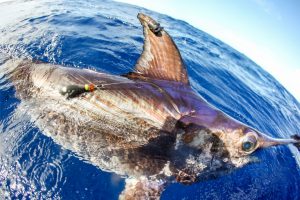Anatomy of a frogfish: New book explores world of fishes with arms and legs

Any old fish can swim. But what fish can walk, scoot, clamber over rocks, change color or pattern and even fight? That would be the frogfish. The latest book by Ted Pietsch, UW professor emeritus of aquatic and fishery sciences, explores the lives and habits of these unusual marine shorefishes. “Frogfishes: Biodiversity, Zoogeography, and Behavioral Ecology” was published in March by Johns Hopkins University Press.
Read moreResident orcas’ appetite likely reason for decline of big Chinook salmon

Each year orcas consume more than 2.5 million adult Chinook salmon along the West Coast. Except for the endangered southern resident population in Washington, all other fish-eating orca populations that live along the coast, called “residents,” are growing in number. The rise of resident killer whales, and their appetite for large Chinook salmon, is driving a decline of the big fish.
Read moreFor some corals, meals can come with a side of microplastics

A new experiment by the University of Washington has found that some corals are more likely to eat microplastics when they are consuming other food, yet microplastics alone are undesirable. Two coral species tested responded differently to the synthetic material, suggesting variations in how corals are adapting to life with microplastics. The study was published Dec. 3 in the journal Scientific Reports.
Read moreSwordfish as oceanographers? Satellite tags allow research of ocean’s ‘twilight zone’ off Florida

Researchers from the University of Washington are using high-tech tags to record the movements of swordfish — big, deep-water, migratory, open-ocean fish that are poorly studied — and get a window into the ocean depths they inhabit.
Read moreHumpback whale population on the rise after near miss with extinction

A population of humpback whales in the South Atlantic has rebounded from the brink of extinction.
Intense pressure from the whaling industry in the 20th century saw the western South Atlantic population of humpbacks diminish to only 450 whales. It is estimated that 25,000 whales were caught over approximately 12 years in the early 1900s.
Protections were put in place in the 1960s as scientists noticed worldwide that populations were declining.
Piranha fish swap old teeth for new simultaneously

With the help of new technologies, a team led by the University of Washington has confirmed that piranhas — and their plant-eating cousins, pacus — do in fact lose and regrow all the teeth on one side of their face multiple times throughout their lives. How they do it may help explain why the fish go to such efforts to replace their teeth.
Read moreInspired by Northern clingfish, researchers make a better suction cup

The finger-sized Northern clingfish employs one of the best suction cups in the world. A small disk on its belly can attach to wet, slimy, even rough surfaces and hold up to 230 times its own body weight. A University of Washington team inspired by the clingfish’s suction power set out to develop an artificial suction cup that borrows from nature’s design. Their prototype, described in a paper published Sept. 9 in the journal Philosophical Transactions of the Royal Society B, actually performed better than the clingfish.
Read moreMark your Calendars for SAFS’s 2019 Autumn Seminar Series

The School of Aquatic and Fishery Science’s (SAFS) annual Autumn Seminar Series begins next week, Thursday, September 26. Be sure to view the SAFS events page and hit the + to subscribe and have information about each week’s presentation added to your calendar. Presentations will also be recorded and uploaded to the SAFS YouTube channel the following day.
Read moreWhat motivates people to join — and stick with — citizen science projects?

One of the most established hands-on, outdoor citizen science projects is the University of Washington-based Coastal Observation and Seabird Survey Team, COASST, which trains beachgoers along the West Coast, from California to Alaska, to monitor their local beach for dead birds. With about 4,500 participants in its 21-year history and roughly 800 active participants today, COASST’s long-term success is now the subject of scientific study in its own right. What makes people join citizen science projects, and what motivates people to stick with them over years?
Read moreDeep submersible dives shed light on rarely explored coral reefs

Just beyond where conventional scuba divers can go is an area of the ocean that still is largely unexplored. In waters this deep — about 100 to at least 500 feet below the surface — little to no light breaks through.
Read more